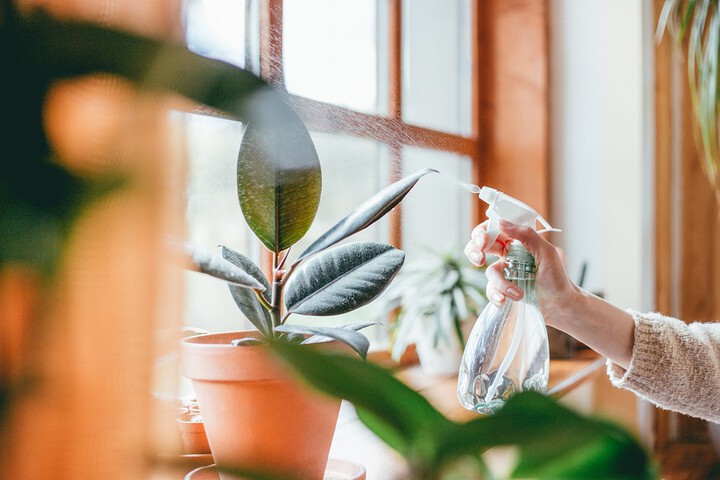An indoor garden expert explains the dos and don'ts of spritzing your plants.

To mist or not to mist? That has long been the question for green thumbs and garden novices alike. "I think a lot of folks believe that misting will raise the humidity for plants that prefer humid conditions, but that would require a lot of spraying," says Summer Rayne Oakes of Homestead Brooklyn. "If you have plants that require high humidity, I would recommend getting a humidifier."
And while Oakes agrees that misting can increase moisture content and humidity, she says it only makes a difference if your plants are in a closed or partially closed container. "For instance, I have a moss terrarium, and I 'water' the container simply by popping off the top of the terrarium and spraying some distilled water onto the moss," she says. "This is very effective, as the moisture is kept in the enclosed container."
In reality, over-misting and spraying your plants can cause them to rot, so it pays to understand when it's actually necessary. To set the record straight, we asked Oakes for advice on when to mist or spray your houseplants at home.
Do mist air plants.
If you have air plants, then Oakes says misting can come in handy. "Air plants (Tillandsia) are foliar feeders, meaning they absorb nutrients and water through their leaves and not through their roots," she explains. "Misting your Tillandsia on a regular basis and then providing air flow afterwards so they don't stay wet for too long is an effective way to keep your air plants thriving."
Do mist sensitive plants that don't require regular watering.
Some plants, such as certain succulents and moss, can't stand being overwatered. "If you have finicky plants with sensitive roots then misting can be really effective," Oakes says. "Additionally, there are some plants that only get their water from fog cover (also known as fog drip), so those plants respond particularly well to misting versus thoroughly watering. This really does depend, however, on the plant in question and your potting medium."
Don't spray certain foliage plants.
According to Oakes, some plants simply won't respond well to misting. "Oftentimes, thin foliage plants with hairs can mold or discolor if they get water on their leaves. African violets and Strawberry begonia comes to mind," she says. "Since we don't often have a lot of air flow in our homes, they don't really get a chance to dry out and this can lead to rot and discoloration on the leaves."
Do pick a comfortable mister.
A good mister can take your indoor gardening game to the next level, but Oakes says to beware of super stylish ones that aren't ergonomically sound. "Make sure you have a mist bottle that doesn't hurt your hands (especially if you're going to do a lot of misting)," she says. "There are some misters that look good, but aren't really that pleasant to use."
Don't use just any kind of water.
If you're using water straight from the tap to mist all your plants, Oakes says you're doing it wrong. "It's important to know what type of water you're using," she says. "For instance, for my air plants and moss, I only use distilled water—not tap—which can contain harmful chemicals like chlorine and fluorine that certain plants are particularly sensitive to."